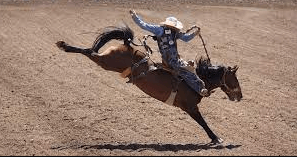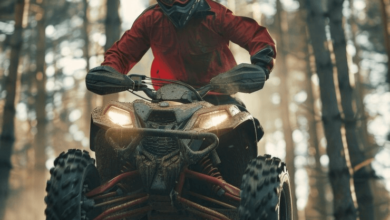How Can One Prepare For A Rodeo Competition?

Rodeo competitions are exhilarating events that showcase the skills and talents of both human and animal athletes. Whether you are a seasoned competitor or a novice looking to enter your first rodeo, proper preparation is crucial for success.
This article aims to provide valuable insights on how one can prepare for a rodeo competition, focusing on understanding the different disciplines of rodeo, physical preparation, and mental readiness.
To embark on a journey towards rodeo excellence, it is essential to have a comprehensive understanding of the various disciplines within this captivating sport. Rodeos typically consist of events such as bull riding, barrel racing, roping, and bronc riding. Each discipline requires its own set of skills and techniques, necessitating specialized training to excel in any particular event. By familiarizing yourself with these disciplines and their unique demands, you can tailor your training regimen accordingly and focus on honing the specific skills required for your chosen event.
Physical preparation plays an integral role in achieving optimal performance at a rodeo competition. The rigorous nature of these events demands athletes who possess strength, agility, balance, and endurance. Engaging in regular physical conditioning exercises that target these attributes will not only enhance your overall athletic ability but also reduce the risk of injuries during high-intensity performances. Additionally, maintaining good nutrition habits and incorporating cross-training activities into your routine will further contribute to your physical prowess in the arena.
In conclusion
Understand the Different Disciplines of Rodeo
The rodeo competition requires an understanding of the various disciplines, such as bull riding, barrel racing, and steer wrestling, which each demand a unique set of skills and techniques.
Rodeo events encompass a wide range of activities that showcase the abilities of both the rider and the animal involved.
Bull riding, for instance, is an exhilarating event that tests a rider’s strength, balance, and fearlessness as they attempt to stay on top of a bucking bull for eight seconds.
Barrel racing focuses on speed and precision as riders navigate their horses through a cloverleaf pattern around three barrels in the fastest time possible.
Steer wrestling requires brute strength and quick reflexes as participants attempt to bring down a running steer by grabbing its horns and wrestling it to the ground.
To excel in these disciplines, one must not only have knowledge of proper technique but also be equipped with appropriate rodeo equipment such as saddles, ropes, protective gear like helmets or vests depending on the event.
Understanding each discipline’s intricacies will allow competitors to better prepare themselves mentally and physically for this exciting sport that embodies freedom in its purest form.
Physical Preparation for Rodeo
To excel in a rodeo competition, it is crucial to focus on physical preparation.
One key aspect is improving riding skills, which involves mastering techniques such as balance and control.
Strengthening the core muscles is also essential for maintaining stability and stamina during rides.
Additionally, practicing roping techniques helps develop precision and speed, improving overall performance in the arena.
By dedicating time and effort to these areas of physical preparation, rodeo athletes can enhance their abilities and increase their chances of success in the sport.
Improve Your Riding Skills
Enhancing equestrian abilities is crucial in order to excel in a rodeo competition.
To improve posture and riding techniques, riders should focus on maintaining a strong and balanced position in the saddle.
This involves keeping the back straight, shoulders relaxed, and heels down.
Developing core strength and flexibility through exercises such as Pilates or yoga can greatly aid in achieving this proper posture.
Additionally, riders should practice various riding techniques such as turning, stopping, and controlling speed to enhance their overall riding skills.
Regularly participating in training sessions with experienced coaches and attending clinics can provide valuable guidance for refining these techniques.
By continually honing their equestrian abilities, riders can increase their chances of success in rodeo competitions while also enjoying the exhilaration that comes from mastering the art of horsemanship.
Strengthen Your Core and Balance
Developing a strong core and improving balance are essential components for riders seeking to excel in rodeo. Studies show that equestrian athletes who have greater core strength and balance have a higher success rate in maintaining proper posture and control while riding.
Core exercises play a crucial role in strengthening the muscles of the abdomen, back, and pelvis, which are vital for stability and control during various maneuvers performed in rodeo competitions. Engaging in exercises such as planks, Russian twists, and bicycle crunches can help build a solid foundation of core strength.
Additionally, incorporating balance training into one’s routine can help riders enhance their ability to stay centered on the horse while navigating challenging obstacles or performing intricate movements. Exercises like standing on one leg or using stability balls can improve proprioception and overall body awareness, allowing riders to better maintain their equilibrium during fast-paced events.
By prioritizing core exercises and balance training as part of their preparation for rodeo competitions, riders can significantly enhance their performance by ensuring they have the necessary strength and stability to excel in this demanding sport.
Practice Roping Techniques
Mastering the art of roping techniques is paramount for rodeo riders seeking to excel in their performance. Roping is a fundamental skill that is essential in various rodeo events and competitions.
To prepare for these challenges, riders must dedicate themselves to practicing and honing their roping techniques. Here are five key aspects that riders should focus on during their practice sessions:
- Accuracy: Precision is crucial when it comes to roping. Riders must aim for the target with accuracy and consistently hit it.
- Speed: Time is of the essence in rodeo competitions, so riders need to develop quick reflexes and execute their rope throws swiftly.
- Coordination: Roping requires a high level of coordination between the rider and horse. Both must work together seamlessly to achieve optimal results.
- Technique: Learning proper technique is vital in achieving success in roping events. Riders should focus on mastering different types of throws, such as headers or heelers, depending on their role in the event.
- Timing: Timing plays a significant role in successful roping. Riders must be able to anticipate the movements of both their horse and the target they are aiming for.
By dedicating time and effort towards practicing these specific aspects of roping techniques, rodeo riders can enhance their performance and increase their chances of success in rodeo competitions and events.
Mental Preparation for Rodeo
Mental preparation is a crucial aspect of rodeo competition, and there are several key points to consider.
Firstly, setting realistic goals and expectations is important to maintain motivation and avoid unnecessary disappointment.
Visualizing successful performances can help athletes develop confidence and mental toughness.
Additionally, developing a pre-competition routine can help riders focus their minds and prepare both mentally and physically for the challenges ahead.
Set Realistic Goals and Expectations
Setting realistic goals and expectations is crucial in preparing for a rodeo competition, as it allows individuals to have a clear understanding of their abilities and limitations, enabling them to effectively plan and strategize their training without indulging in unrealistic fantasies of achieving perfection.
By setting specific and achievable goals, rodeo competitors can focus their efforts on improving specific areas of their performance, whether it be perfecting a particular maneuver or increasing their overall speed. This approach helps to create a sense of direction and purpose in training, allowing individuals to measure their progress over time and make necessary adjustments along the way.
Furthermore, managing expectations plays a vital role in maintaining mental resilience during the preparation process. Recognizing that setbacks and challenges are inevitable allows individuals to embrace these obstacles as opportunities for growth rather than viewing them as failures.
By setting realistic expectations, rodeo competitors can maintain a positive mindset even when faced with difficulties, staying motivated to persevere through the rigorous training required for success in the arena.
In conclusion, setting realistic goals and managing expectations not only provides structure and focus during rodeo preparation but also fosters mental resilience that is essential for overcoming challenges on the path to achieving excellence in this demanding sport.
Visualize Successful Performances
Visualizing successful performances can enhance the performance of rodeo athletes by allowing them to mentally rehearse their routines and anticipate potential challenges they may encounter in the arena.
Through mental imagery, athletes can vividly imagine themselves executing each movement with precision and grace, creating a sense of familiarity and confidence.
This visualization process not only helps athletes physically prepare for their routines but also mentally prepares them for any unexpected situations that may arise during the competition.
By visualizing successful performances, rodeo athletes can also use positive affirmations to reinforce their belief in their abilities and maintain a positive mindset throughout the competition.
These affirmations serve as reminders of their skills, talents, and dedication, boosting their self-esteem and motivation to perform at their best.
Overall, incorporating mental imagery and positive affirmations into their preparation can significantly improve the performance of rodeo athletes by enhancing focus, reducing anxiety, promoting resilience, and maximizing their overall potential in the arena.
Develop a Pre-Competition Routine
Developing a pre-competition routine is an essential aspect of preparing for a rodeo competition. This routine serves as a structured sequence of actions and mental preparations that help riders develop focus and manage nerves before their performance.
A well-developed routine provides a sense of familiarity and control, allowing competitors to enter the arena with confidence. It typically involves physical warm-up exercises to loosen muscles, mental visualization techniques to envision successful performances, and relaxation strategies to calm nerves.
By consistently following this routine during training sessions, riders can condition themselves to perform at their best when it truly matters. Additionally, incorporating breathing exercises or meditation into the pre-competition routine can further enhance concentration and promote a state of calmness in the midst of the adrenaline-fueled atmosphere at rodeo events.
Ultimately, by dedicating time and effort towards developing an effective pre-competition routine, riders can optimize their mental and physical states leading up to each competition, improving their chances of success in the exhilarating world of rodeo.
Frequently Asked Questions
What are some common injuries that can occur in rodeo competitions?
Preventing rodeo injuries is crucial in ensuring the safety and well-being of participants. Common rodeo injuries include broken bones, concussions, and spinal injuries. Proper training, equipment, and adherence to safety protocols are essential in minimizing these risks.
How can I improve my balance and coordination for rodeo events?
Improving balance and coordination for rodeo events is crucial. Core strength is important to maintain stability and control during rides. Additionally, incorporating yoga can enhance flexibility, allowing for better maneuverability and reducing the risk of injuries.
Are there any specific exercises or workouts that can help with bull riding?
Exercises and techniques for bull riding include core strength training, balance exercises, and practicing on a mechanical bull. These activities help riders develop the necessary skills to maintain control and balance while riding a bucking bull during a rodeo competition.
What are some tips for managing nerves and anxiety before a rodeo competition?
Tips for visualization and breathing techniques for relaxation can help manage nerves and anxiety before a rodeo competition. Visualizing success and using deep breathing exercises can calm the mind, increase focus, and enhance performance in high-pressure situations.
Are there any specific techniques or strategies that can help with calf roping or barrel racing?
To master the art of calf roping or barrel racing, specific training techniques are essential. Developing precise timing, balance, and coordination is crucial for success in these events. Tips for improving skills include practicing consistently, studying professional riders, and seeking expert guidance.
Conclusion
In conclusion, preparing for a rodeo competition requires a comprehensive understanding of the different disciplines involved, as well as physical and mental readiness.
By familiarizing oneself with events such as bull riding, steer wrestling, and barrel racing, competitors can develop specific skills and techniques necessary to excel in each discipline.
Additionally, engaging in physical training regimens that focus on strength, endurance, and agility will enhance one’s performance in the arena.
Likewise, mental preparation through visualization exercises and maintaining a positive mindset is crucial for managing the intense pressure and unpredictability of rodeo competitions.
Interestingly, statistics show that rodeo competitions are not just limited to the United States but have also gained popularity worldwide.
According to recent data from the International Professional Rodeo Association (IPRA), there are over 30 countries actively participating in professional rodeos.
This global reach highlights the widespread appeal of this thrilling sport beyond its American roots.
From Canada to Australia and even parts of Europe, individuals from all corners of the world are captivated by the excitement and skill demonstrated by rodeo athletes.
This statistic serves as a testament to the enduring passion for rodeo across cultures and showcases its universal appeal.
Overall, preparing for a rodeo competition involves immersing oneself in various disciplines while dedicating time and effort towards physical training and mental fortitude.
As an internationally recognized sport enjoyed by people worldwide, rodeo continues to capture hearts with its adrenaline-fueled performances that showcase both human athleticism and harmony with powerful animals.
So whether you are aspiring to compete or simply appreciate the skill required in this captivating sport, understanding how one prepares for a rodeo competition will undoubtedly deepen your appreciation for this exhilarating event.



